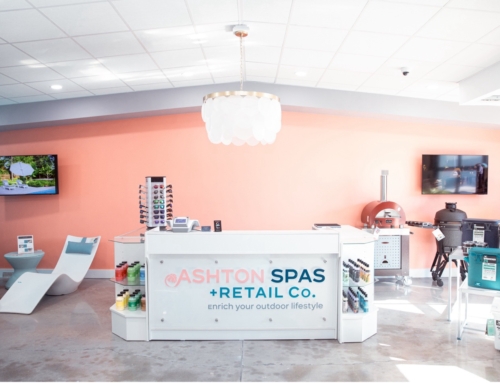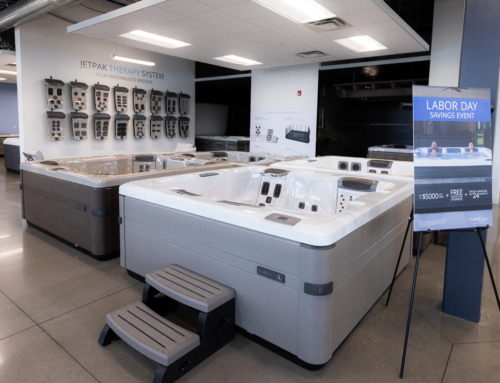Many spa store owners are laser-focused on the three commandments of refining a retail business: improving customer experience, sales conversion, and, ultimately, profitability. But case studies and an enormous body of anecdotal evidence suggest one compelling sales counter exchange can boost all three of those business segments.
Offer customers consumer financing.
“When I hear a dealer say they don’t need consumer financing because all their customers pay cash, the first thing I think is: you’re missing out on 50% of sales,” says Jim Sueppel, VP of Sales at Bullfrog Spas. “We know not everybody can pay cash for hot tubs, but they would qualify for financing. So by not offering it, you are turning away sales.”
Retailers aren’t just losing sales, notes Todd Shannon, Bullfrog’s VP of Business Development, they are hurting profitability. “Study after study shows that leveraging consumer financing improves customer experience and profitability.”
Shannon conducted a case study involving a spa retailer who shifted from a cash-only to a finance model. The switch completely transformed business.
“Here’s the number that will make sense to the general reader,” he said, referencing the study. “The store’s margin went up 14 percent, and its profit increased 70 percent year-over-year. The number of units they sold went up 40 percent. The average sale price went up 11 percent, and the average amount of accessories sold went up 64 percent.”
The Reasons for Resistance
With growth like that, why are spa dealers resistant to offering consumer financing?
The answer depends on the owner, of course. But most dealer objections center on three general concerns:
- That consumer financing will burden a business with extra costs, as the business will pay a percentage of the sale to a financing company.
- That financing means eliminating dealer discounts, which will hurt conversion rates.
- Offering and executing financing is more trouble than it’s worth.
- That customers who purchase luxury items have no interest in financing, so it’s unnecessary.
While all these concerns are understandable, Bullfrog’s sales experts believe spa retailers’ resistance to offering consumer financing is a case of perception. “If I have something that’s a cost center, I look to control those costs,” explains Shannon. “Instead, I encourage retailers to see financing as an opportunity center to either create a better customer experience or to help overcome common sales objections.”
With that last point in mind, here’s a point-by-point look at retailer concerns, and the case for offering consumer financing.
Extra Cost or Extra Profit
“Often a dealer will say, ‘financing will cost me X number of percent. I can’t afford that.’” recounts Shannon, noting that if a dealer offers a customer five-year financing with zero interest zero down payment, they might be charged as much as 15% of the sale.
For stores with cash-only pricing strategies, this is a legitimate concern.
However, data shows financing has a snowball effect on profits. Offering financing to customers not only increases conversion — often because it makes an expensive luxury item more affordable — it also increases average order size, according to multiple studies.
That’s because luxury item shoppers that use financing are more likely to go all-in on a purchase. When it comes to the accessory-rich world of expensive spas, Shannon reports retailers have found customers are more likely to add extra items at the initial purchase instead of waiting for their cash flow to improve.
“Adding a thousand dollar sound system to your purchase doesn’t feel like a big hit if it winds up costing you $10 more dollars a month.”
It’s also worth noting that dealerships already absorb a financing charge every time a customer uses a credit or charge card. “Depending on the card, retailers are paying the credit card companies anywhere from 2 to 5 percent on each purchase.” says Sueppel, “If a customer wants to make a partial payment, financing charges for the retailer may not be that much higher.”
One Price Fits All
All-cash businesses often offer discounts to customers, using them as a way to incentivize sales.
Since finance firms require strict, across-the-board pricing, that familiar discount dance, a tried and true conversion tool, will be eliminated for stores that offer financing.
Once again, Shannon points to increased conversion statistics as proof that a fixed-price strategy that offers financing makes better business sense discounting.
“If you set up your pricing strategy properly, you will find that you can have a lot more profitability for your business at the end of the year.”
There are other upsides to a fixed price strategy, too. It simplifies store management by making deal approvals a thing of the past. Gone are haggling customers or angry buyers who learn someone got a better deal.
Credit Approval in the Digital Age
For retailers used to credit approval processes of the past, the idea that consumer financing is time-consuming is understandable — especially to anyone who remembers spending an hour or two in a car dealership awaiting approval as documents are faxed back and forth.
But things have changed.
Sueppel notes that financing companies have reduced the friction regarding financing approval. “They’re invested in making this simple. Some offer a QCR code for customers to scan. This allows them to sign-up for financing on their phone. Others let you do it on websites.”
As for training staff to accept the new form of payment, all you need is a web connection to watch live webinars with question and answer sessions or view pre-recorded training videos.
Meanwhile, using a third-party finance company may actually reduce back-office work. The finance company collects payments and absorbs some of the legal risks for non-payment. Not only that, the retail receives its full compensation as soon as financing is approved.
The Cash Only Question
Even if a business has a history of solid cash-only business, Bullfrog’s sales experts believe the addition of consumer financing should be viewed as a powerful new incentive to both new and old customers.
“The customer can decide whether it’s right for them or not. Dealers shouldn’t make that decision for them,” stresses Shannon. “Retailers don’t have to push it, just make it available to their customers and let them decide if it’s right for them or not.”
For Sueppel, that choice can create a great customer experience. “Financing can be a big value proposition. Retailers can use it to say this is going to help you do what you really want and have the features that you will really enjoy. It can make a sale possible for some buyers. That kind of positive customer experience will lead to all kinds of new dividends: increased lifetime customer value, repeat business, added referrals, and increased profits.”








Leave A Comment